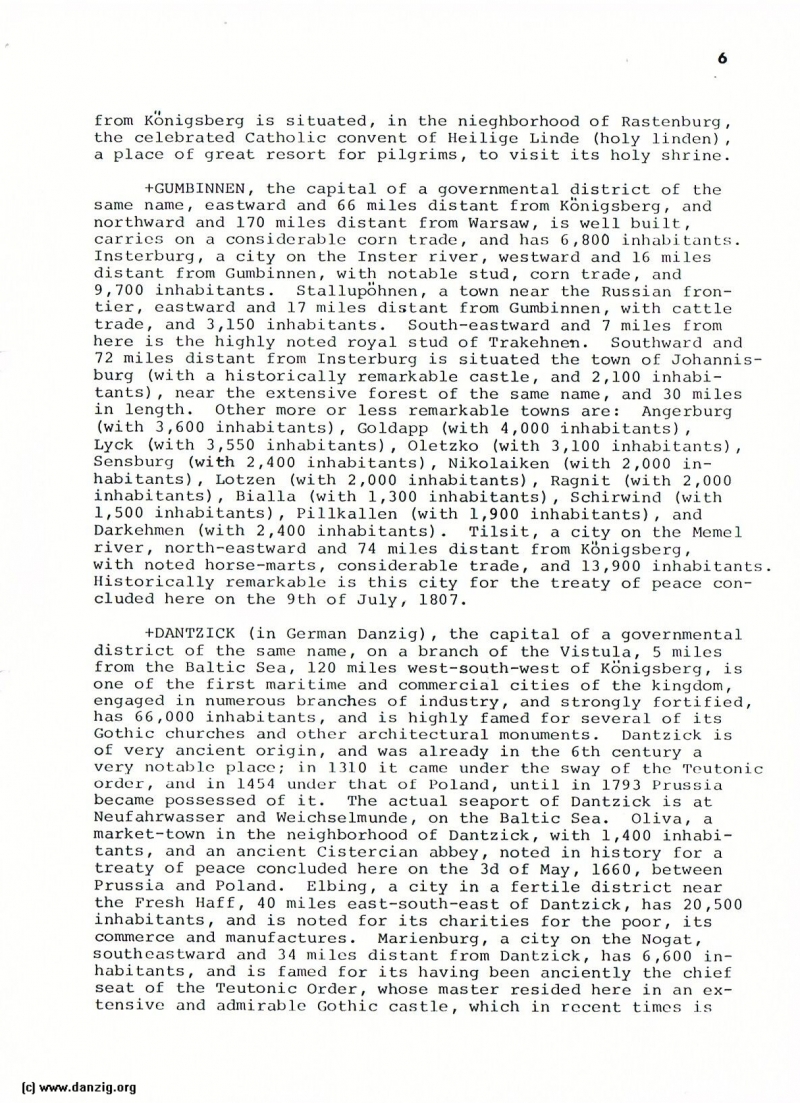
>> THE PROVINCE OF PRUSSIA
from Königsberg is situated, in the neighborhood of Rastenburg, the celebrated Catholic convent of Heilige Linde (holy linden) , a place of great resort for pilgrims, to visit its holy shrine.
+ GUMBINNEN, the capital of a governmental district of the same name, eastward and 66 miles distant from Königsberg, and northward and 170 miles distant from Warsaw, is well built, carries on a considerable corn trade, and has 6,800 inhabitants. Insterburg, a city on the Inster river, westward and 16 miles distant from Gumbinnen, with notable stud, corn trade, and 9,700 inhabitants. Stallupbhnen, a town near the Russian frontier, eastward and 17 miles distant from Gumbinnen, with cattle trade, and 3,150 inhabitants. South-eastward and 7 miles from here is the highly noted royal stud of Trakehneri. Southward and 72 miles distant from Insterburg is situated the town of Johannisburg (with a historically remarkable castle, and 2,100 inhabitants) , near the extensive forest of the same name, and 30 miles in length. Other more or less remarkable towns are: Angerburg (with 3,600 inhabitants) , Goldapp (with 4,000 inhabitants) , Lyck (with 3,550 inhabitants) , Oletzko (with 3,100 inhabitants) , Sensburg (with 2,400 inhabitants) , Nikolaiken (with 2,000 inhabitants), Lotzen (with 2,000 inhabitants), Ragnit (with 2,000 inhabitants) , Bialla (with 1,300 inhabitants) , Schirwind (with 1,500 inhabitants) , Pilikallen (with 1,900 inhabitants) , and Darkehmen (with 2,400 inhabitants) . Tilsit, a city on the Memel river, north-eastward and 74 miles distant from Königsberg, with noted horse-marts, considerable trade, and 13,900 inhabitants. Historically remarkable is this city for the treaty of peace concluded here on the 9th of July, 1807.
+ DANTZICK (in German Danzig), the capital of a governmental district of the same name, on a branch of the Vistula, 5 miles from the Baltic Sea, 120 miles west-south-west of Königsberg, is one of the first maritime and commercial cities of the kingdom, engaged in numerous branches of industry, and strongly fortified, has 66,000 inhabitants, and is highly famed for several of its Gothic churches and other architectural monuments. Dantzick is of very ancient origin, and was already in the 6th century a very notable place; in 1310 it came under the sway of the Teutonic order, and in 1454 under that of Poland, until in 1793 Prussia became possessed of it. The actual seaport of Dantzick is at Neufahrwasser and Weichselmunde, on the Baltic Sea. Oliva, a market-town in the neighborhood of Dantzick, with 1,400 inhabitants, and an ancient Cistercian abbey, noted in history for a treaty of peace concluded here on the 3d of May, 1660, between Prussia and Poland. Elbing, a city in a fertile district near the Fresh Baff, 40 miles east-south-east of Dantzìck, has 20,500 inhabitants, and is noted for its charities for the poor, its commerce and manufactures. Marienburg, a city on the Nogat, southeastward and 34 miles distant from DanLzick, has 6,600 inhabitants, and is famed for its having been anciently the chief seat of the Teutonic Order, whose master resided here in an extensivo and admirable Gothic castle, which in recent times is
Danzig Report Nr. 17 – 1st Quarter 1978, Page 6.
Hits: 3408
Added: 06/06/2015
Copyright: 2025 Danzig.org

